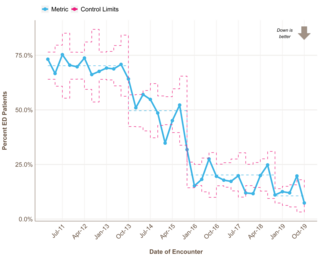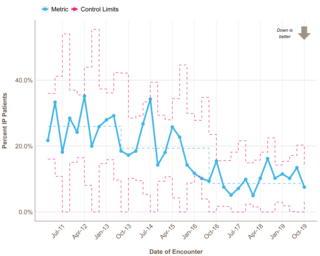Why is this important?
Bronchiolitis, a respiratory illness caused by viruses, occurring especially during the winter months, is the second most common reason for infants to be hospitalized. Wheezing is a common symptom of bronchiolitis, and clinicians often try to treat it with asthma medications such as albuterol. However, multiple research studies have shown that this is not an effective practice, and the American Academy of Pediatrics has recommended against albuterol use to prevent side effects and unnecessary treatment. Despite this, hospitals across the United States have struggled to reduce albuterol use.
What we did
A multidisciplinary team at Children's Hospital of Philadelphia (CHOP) worked together to change the Emergency Department (ED) and Inpatient Bronchiolitis pathways. This work included improving the order sets to make it easier to order nasal suctioning, but also clearly recommended not to use albuterol (sometimes called the “Do Not Order Set”). Hospitalization rate and revisits back to the Emergency Department did not change.
Results
Percent of Children with Bronchiolitis in the ED who Received Albuterol
Albuterol use decreased from 68 percent to 44 percent to 18 percent over three winter seasons as the pathway changed from offering it as an option to recommending against regular use.

Percent of Children with Bronchiolitis on the Inpatient Unit who Received Albuterol
Albuterol use decreased from 21 percent to 11 percent as the pathway changed from offering it as an option to recommending against regular use.

Updated May, 2020
Why is this important?
Bronchiolitis, a respiratory illness caused by viruses, occurring especially during the winter months, is the second most common reason for infants to be hospitalized. Wheezing is a common symptom of bronchiolitis, and clinicians often try to treat it with asthma medications such as albuterol. However, multiple research studies have shown that this is not an effective practice, and the American Academy of Pediatrics has recommended against albuterol use to prevent side effects and unnecessary treatment. Despite this, hospitals across the United States have struggled to reduce albuterol use.
What we did
A multidisciplinary team at Children's Hospital of Philadelphia (CHOP) worked together to change the Emergency Department (ED) and Inpatient Bronchiolitis pathways. This work included improving the order sets to make it easier to order nasal suctioning, but also clearly recommended not to use albuterol (sometimes called the “Do Not Order Set”). Hospitalization rate and revisits back to the Emergency Department did not change.
Results
Percent of Children with Bronchiolitis in the ED who Received Albuterol
Albuterol use decreased from 68 percent to 44 percent to 18 percent over three winter seasons as the pathway changed from offering it as an option to recommending against regular use.

Percent of Children with Bronchiolitis on the Inpatient Unit who Received Albuterol
Albuterol use decreased from 21 percent to 11 percent as the pathway changed from offering it as an option to recommending against regular use.

Updated May, 2020